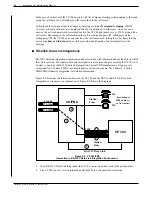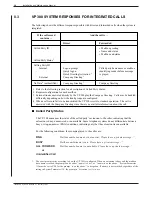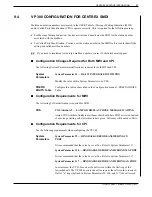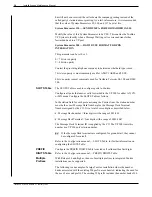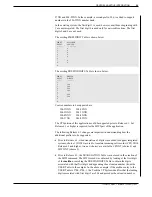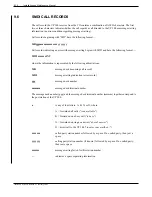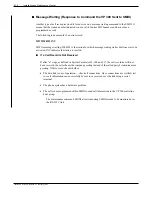
CENTREX SMDI LIMITATIONS
The VP 300 is restricted in how it interfaces with Centrex. The customer should be advised on these issues
and care should be taken not to forward all stations to the VP 300, depending on who typically calls the
station.
Sequential
Sequential Forwarding is illustrated by the following:
Forwarding
Station 2311 is forwarded to 2312 and 2312 is in turn forwarded to the VP 300.
When a call is forwarded from 2311 to 2312, and then to the VP 300, the Centrex
SMDI software tells the VP 300 that the call came from 2312, not the originally
called station, 2311. The VP 300 treats the call as though the caller had intended to
dial 2312, and gives the wrong name or greeting. Sequential forwarding should be
avoided!
SMDI Performance
When Centrex becomes busy, sending data to the VP 300 is slowed down. The VP
300 can wait up to the amount of rings defined in System Parameter 99, 100, or
117 for information sent from the CO. If the information is not sent, the VP 300
answers with the company greeting, not the called party's mailbox information.
Refer to the Centrex Configuration section.
SMDI Link
If more than one VP 300 cabinet is required, additional SMDI links are required,
one for each cabinet. Stations must be forwarded to the appropriate cabinet.
DMS-100 and
In the past, the DMS-100 and SL-100 did not send call records on direct external
SL-100
calls. For this reason, the VP 300 took longer to answer the port because it was
waiting for the call record. This was improved with corrected software release
BCS 26 for the DMS-100 and SL-100.
•
When a caller accesses the VP 300, then abandons the call, the DMS-100 and
the SL-100 will route the VP 300 port, which is off hook, to a recorded
announcement. The announcement will be recorded as a message in the called
party's mailbox. This can cause the disk to fill up.
The DMS-100/SL-100 has a feature available called COD, which offers the VP
300 a momentary disconnect. With System Parameter 77 set to YES, the VP
300 uses that momentary disconnect to determine when the called party
abandons, and this problem is eliminated.
•
Transfer for Uniform Call Distribution (UCD) has been expanded beyond the
original call transfer capability of UCD groups. It now allows UCD group
members and non-UCD group members to transfer calls to other UCD groups.
This expanded capability increases the customer's call handling flexibility. For
example, a three-way call chain can include a transferred call to a UCD group.
This feature, included in the NTX101AA package available with BCS 27, on
DMS-100, now permits transfer into the UCD that contains ports for a voice
mail system. Formerly, this transfer could not be done because it involved Call
Forwarding Busy (CFB) and Call Forwarding Universal (CFU).
An enhancement in BCS 28, on DMS-100 feature #AG 1541, enables this
transfer for Call Forward Do Not Answer conditions. Feature #AG 1541 can be
patched to BCS 27.
Toshiba VP Systems Release 6.1 February, 1993
9-4
Installation and Maintenance Manual
9.2
Содержание VP 300
Страница 2: ......
Страница 10: ......
Страница 14: ......
Страница 19: ...Quick Reference Guide Hardware Toshiba VP 300 System Specifications Toshiba VP Systems Release 7 1 July 1994 ...
Страница 20: ...Toshiba VP Systems Release 7 1 July 1994 ...
Страница 52: ...Toshiba VP Systems Release 6 1 February 1993 2 14 Installation and Maintenance Manual ...
Страница 56: ...Toshiba VP Systems Release 7 1 July 1994 ...
Страница 146: ......
Страница 312: ...Toshiba VP Systems Release 7 1 July 1994 ...
Страница 314: ......
Страница 444: ......
Страница 496: ......
Страница 542: ......
Страница 598: ...Toshiba VP Systems Release 6 1 February 1993 ...
Страница 600: ...Toshiba VP Systems Release 6 1 February 1993 ...





